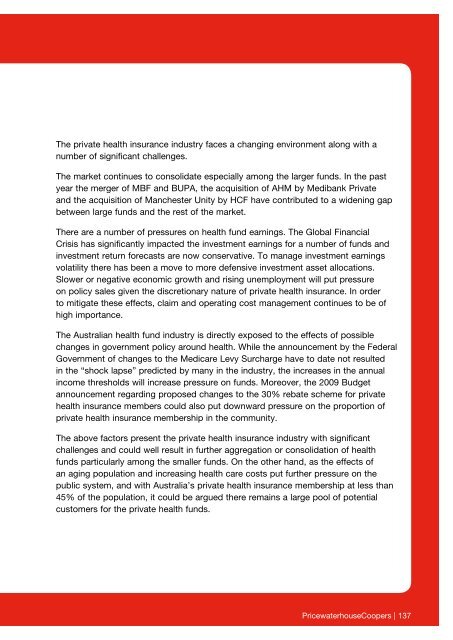Insurance - PricewaterhouseCoopers
Insurance - PricewaterhouseCoopers
Insurance - PricewaterhouseCoopers
Create successful ePaper yourself
Turn your PDF publications into a flip-book with our unique Google optimized e-Paper software.
The private health insurance industry faces a changing environment along with a<br />
number of significant challenges.<br />
The market continues to consolidate especially among the larger funds. In the past<br />
year the merger of MBF and BUPA, the acquisition of AHM by Medibank Private<br />
and the acquisition of Manchester Unity by HCF have contributed to a widening gap<br />
between large funds and the rest of the market.<br />
There are a number of pressures on health fund earnings. The Global Financial<br />
Crisis has significantly impacted the investment earnings for a number of funds and<br />
investment return forecasts are now conservative. To manage investment earnings<br />
volatility there has been a move to more defensive investment asset allocations.<br />
Slower or negative economic growth and rising unemployment will put pressure<br />
on policy sales given the discretionary nature of private health insurance. In order<br />
to mitigate these effects, claim and operating cost management continues to be of<br />
high importance.<br />
The Australian health fund industry is directly exposed to the effects of possible<br />
changes in government policy around health. While the announcement by the Federal<br />
Government of changes to the Medicare Levy Surcharge have to date not resulted<br />
in the “shock lapse” predicted by many in the industry, the increases in the annual<br />
income thresholds will increase pressure on funds. Moreover, the 2009 Budget<br />
announcement regarding proposed changes to the 30% rebate scheme for private<br />
health insurance members could also put downward pressure on the proportion of<br />
private health insurance membership in the community.<br />
The above factors present the private health insurance industry with significant<br />
challenges and could well result in further aggregation or consolidation of health<br />
funds particularly among the smaller funds. On the other hand, as the effects of<br />
an aging population and increasing health care costs put further pressure on the<br />
public system, and with Australia’s private health insurance membership at less than<br />
45% of the population, it could be argued there remains a large pool of potential<br />
customers for the private health funds.<br />
<strong>PricewaterhouseCoopers</strong> | 137

















